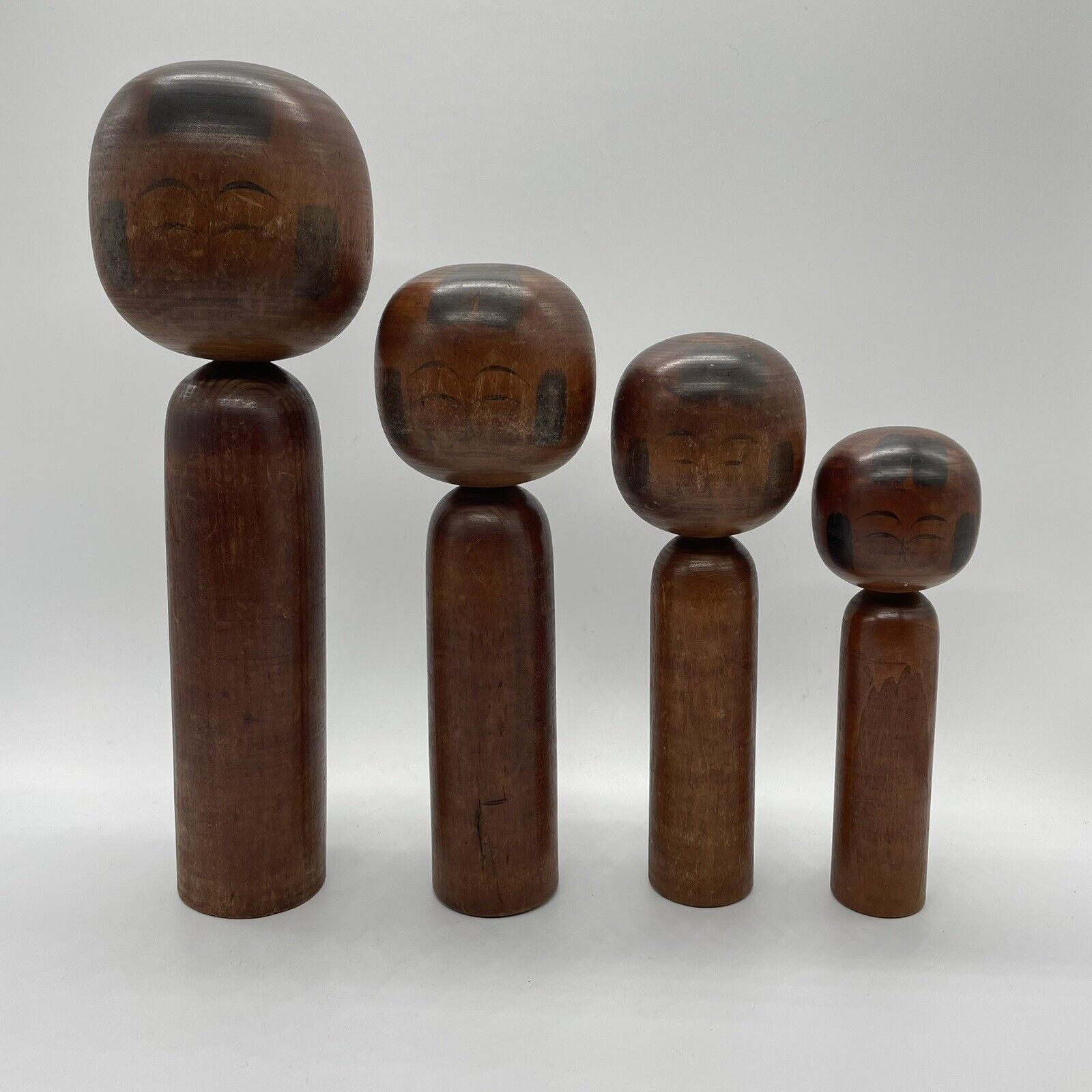 On eBay Now...
On eBay Now...Rare Very Old kokeshi japanese 4 dolls lot Nice Aged Sugawara Shōshichi 1895– For Sale

When you click on links to various merchants on this site and make a purchase, this can result in this site earning a commission. Affiliate programs and affiliations include, but are not limited to, the eBay Partner Network.
Rare Very Old kokeshi japanese 4 dolls lot Nice Aged Sugawara Shōshichi 1895–:
$250.00
Rare Very Old kokeshi japanese 4 dolls lot Nice Aged Sugawara Shōshichi 1895–1972About This Items
- Kokeshi hand made by Sugawara Shōshichi 1895–
Large 13.4 inch / 34 cm TallMidium 11.8 inch / 30 cm TallSmall 7 inch / 18 cm Tall
Beautiful Drawing at bodies.
Sugawara Shōshichi (1895–1972)Lineage: Togatta Style
Master: Sato SanzōDisciples: Sugawara Satoshi
Biography:
Sugawara Shōshichi was born on April 22, 1895, in Nakano Tamachimae, Toriya Saki, Kurihara District, Kurikoma Town, Miyagi Prefecture, to a farming family headed by Sugawara Tōji and his wife Miyoshi. After completing high school, he helped with the family business before being introduced by his aunt Yoshino to Fumi Ota of Akiu, where he began his apprenticeship in woodturning. Although Ota Shōkichi, the head of the Ota family, had passed away, Shōshichi started his training under Sato Sanzō, Shōkichi’s disciple. Later, Yoshino married Sanzō.
During this period, Shōshichi became proficient in making kokeshi, producing around 20 to 30 six-inch dolls per hour and approximately 100 dolls daily. Sanzō entrusted him with most of the painting work, recognizing his exceptional skill. Several craftsmen, including Sato Konosuke from Aone, were part of Sanzō’s team.
In 1914, although Shōshichi underwent military inspection, he did not serve and continued his work at the Ota household. When Sanzō left the Ota family in the autumn of 1916 to establish his own workshop, Shōshichi followed him. Around the time of the closure of the Akiu Village Woodturning School in February 1920, Sanzō transferred his woodturning business to his son Yoshio and focused on farming, leading Shōshichi to establish his own workshop near the Mito-ya Ryokan in Yumoto.
The fifth son of the Mito-ya Ryokan’s owner, Yamawo Kesasaburō, was Yamawo Takeji, another of Sanzō’s disciples and a graduate of the Akiu Village Woodturning School. Takeji learned kokeshi painting by observing his senior disciple, Shōshichi.
On September 14, 1926, Shōshichi married Tomeyo, the fourth daughter of Yamawo Buzirō from Yumoto, and they had one son, Satoshi. After World War II, in the 1950s, Shōshichi moved to a new home in Yumoto Yakushi. From 1960, he taught woodturning to his son Satoshi. Although health issues due to high blood pressure reduced his productivity after 1961, he continued making kokeshi in small quantities whenever he felt well. He passed away in Akiu on February 12, 1972, at the age of 78. From around 1970, his wife Tomeyo also began assisting in the painting of kokeshi made by their son Satoshi.
Despite a brief period working at the Goishikawa Power Plant on the downstream of the Natori River during an economic downturn in the early Shōwa period, Shōshichi dedicated his life to woodturning.
Renowned as one of the most active and prolific kokeshi artisans before the war, Shōshichi’s legacy was highlighted by Tokio Shikama, who named him alongside Takahashi Musashi of Naruko and Saito Genkichi of Zaō Takayu as one of the three great traditional kokeshi makers of the Used
Kokeshi are traditional Japanese wooden dolls, characterized by their simple yet elegant design. They originated in the Tohoku region of Japan during the Edo period (1603-1868). These dolls are made from wood and typically feature a simple cylindrical body with a rounded head. Here are some key aspects of Kokeshi dolls:
Types of KokeshiTraditional Kokeshi (Dento Kokeshi)
- These are the original forms of Kokeshi, handcrafted and typically passed down through generations of artisans.
- They are classified into several regional styles, each with its own unique features and patterns, such as Naruko, Tsuchiyu, Yajiro, and others.
- The designs often include hand-painted floral or geometric patterns, and the dolls are usually left unvarnished.
Creative Kokeshi (Shingata Kokeshi)
- These emerged after World War II and allow for more artistic freedom.
- Unlike traditional Kokeshi, they are not restricted by regional styles or patterns, leading to a variety of innovative designs and forms.
- They may include more elaborate decorations, different shapes, and varnished style="border: 0px solid rgb(227, 227, 227); box-sizing: border-box; --tw-border-spacing-x: 0; --tw-border-spacing-y: 0; --tw-translate-x: 0; --tw-translate-y: 0; --tw-rotate: 0; --tw-skew-x: 0; --tw-skew-y: 0; --tw-scale-x: 1; --tw-scale-y: 1; --tw-pan-x: ; --tw-pan-y: ; --tw-pinch-zoom: ; --tw-scroll-snap-strictness: proximity; --tw-gradient-from-position: ; --tw-gradient-via-position: ; --tw-gradient-to-position: ; --tw-ordinal: ; --tw-slashed-zero: ; --tw-numeric-figure: ; --tw-numeric-spacing: ; --tw-numeric-fraction: ; --tw-ring-inset: ; --tw-ring-offset-width: 0px; --tw-ring-offset-color: #fff; --tw-ring-color: rgba(69,89,164,.5); --tw-ring-offset-shadow: 0 0 transparent; --tw-ring-shadow: 0 0 transparent; --tw-shadow: 0 0 transparent; --tw-shadow-colored: 0 0 transparent; --tw-blur: ; --tw-brightness: ; --tw-contrast: ; --tw-grayscale: ; --tw-hue-rotate: ; --tw-invert: ; --tw-saturate: ; --tw-sepia: ; --tw-drop-shadow: ; --tw-backdrop-blur: ; --tw-backdrop-brightness: ; --tw-backdrop-contrast: ; --tw-backdrop-grayscale: ; --tw-backdrop-hue-rotate: ; --tw-backdrop-invert: ; --tw-backdrop-opacity: ; --tw-backdrop-saturate: ; --tw-backdrop-sepia: ; --tw-contain-size: ; --tw-contain-layout: ; --tw-contain-paint: ; --tw-contain-style: ; list-style-position: initial; list-style-image: initial; margin: 0px 0px 1.25em; padding: 0px 0px 0px 1.625em;">
- Materials: Made from different types of wood, such as cherry, dogwood, or chestnut, each providing a distinct texture and finish.
- Construction: Traditionally, Kokeshi dolls are lathe-turned and hand-painted. The head is often a separate piece attached to the body.
- Design: Typically, the dolls have no arms or legs. The facial features are simple, often just eyes and a mouth, with minimal detail.
- Sizes: They come in various sizes, from a few inches to over a foot tall.
- Symbolism: Kokeshi dolls are often associated with protection against evil and are believed to bring good luck. They are sometimes given as gifts for good fortune or to comfort someone who is grieving.
- Craftsmanship: The making of Kokeshi dolls is a respected art form, with many artisans dedicating their lives to perfecting their craft. Each region's style represents its unique cultural heritage.
- Modern Appeal: While rooted in tradition, Kokeshi dolls have seen a resurgence in popularity, appealing to both collectors and those interested in traditional Japanese art and culture.
- Authenticity: Collectors often seek traditional Kokeshi made by renowned artisans, each piece often signed and dated.
- Value: The value of a Kokeshi doll can vary greatly depending on its age, condition, and the reputation of the artist.
- Display: They are commonly displayed in homes, both as decorative items and as symbols of cultural pride.
Kokeshi dolls embody a blend of simplicity and elegance, making them cherished items in Japanese culture and a fascinating subject for collectors and enthusiasts worldwide.
Shipping- We always send the item with a tracking number. So please place an order without any concern on delivery. You can always track the delivery status.
- Shipping is only available to the address registered in . If you want us to send another address, please change your address on and then place an order.
- Shipping is available from Monday to Friday. Weekends are not available because freight (shipping) companies are closed.
- We do not mark merchandise values below value or mark items as ?gifts? ? Japan, US and International government regulations prohibit such behavior.
- If your address is in the remote areas defined by the freight (shipping) company, please pay the additional shipping fees with PayPal.
Import duties, taxes, and charges are not included in the item price or shipping cost. These charges are the buyer's responsibility. Please check with your country's customs office to determine what these additional costs will be prior to offerding or buying.
Thank you for your understanding.
Related Items:VRHTF VTG RARE VERY COOL NISSAN GT-R POWER CAR EMBLEM 1.5" X 5" ADHESIVE BACK
$49.99
Rare Very HTF 1st Edition Witchy Tarot 2003 Aka Teen Witch Tarot Made in Italy
$243.16
Super rare very large Super 7, Sacred Seven polished point 694g SN54311
$304.22








